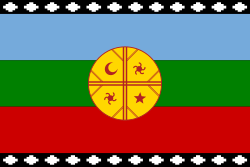Huilliche language
| Huilliche | |
|---|---|
| Chesungun, chedungun | |
| Native to | Chile |
| Ethnicity | Huilliche people |
Native speakers | (2,000 cited 1982)[1] |
|
Araucanian
| |
| Language codes | |
| ISO 639-3 |
huh |
| Glottolog |
huil1244[2] |
Huilliche (which can also be found spelt Williche, Huiliche or Veliche) is a branch of the Araucanian language family. In 1982 it was spoken by about 2,000 ethnic Huilliche people in Chile.[3] It is spoken in the nation's Los Lagos and Los Ríos regions; and mountain valleys, between the city of Valdivia and south toward Chiloé Archipelago.
Huilliche is composed of at least two varieties, called Huillichesungun and Tsesungun by their speakers. Huillichesungun is spoken in Wequetrumao, on the island of Chiloé, and Tsesungun is spoken Choroy Traiguen, on the coast of Osorno province.[4] Huilliche is closely related to Mapudungun, the language of the Mapuche, though more research is needed to determine the degree of mutual intelligibility between the two. The "Enduring Voices" project of National Geographic reports the following:
"They are to some degree hidden within the broader Mapuche ethnic group, yet consider themselves quite distinct in both language and identity [...] Though the two languages [Huillichesungun and Tsesungun] may share as many as 80% of basic words, we confirmed that they differ in their sounds and grammar, as well as in their ethno-linguistic identity [...] Unexpectedly, Tsesungun, though it is geographically closer to Mapudungun, is less similar to it."
The Jesuit priest Luis de Valdivia reported in 1606 that there was linguistic unity in the territory between Coquimbo and Chiloé, from the Pacific to the Andes, and that this was composed of varieties whose differences were mostly in pronunciation and vocabulary. This analysis is supported by researchers at the end of the 19th and beginning of the 20th century, such as Félix de Augusta or Rodolfo Lenz, and by those in the second half of the 20th century, such as Robert Croese. The latter two noted that Huilliche was the most divergent of the varieties of Araucanian, as did Pilar Álvarez-Santullano, a researcher in the phonology and syntax of Chesungun on the Osorno coast.
Most Huilliche speakers are older adults, and most ethnic Huilliche speak Spanish as their first language, making both Huilliche varieties highly endangered.
See also
References
- ↑ Huilliche at Ethnologue (18th ed., 2015)
- ↑ Hammarström, Harald; Forkel, Robert; Haspelmath, Martin; Bank, Sebastian, eds. (2016). "Huilliche". Glottolog 2.7. Jena: Max Planck Institute for the Science of Human History.
- ↑ "Huilliche".
- ↑ Harrison, David K. "Enduring Voices in Chile—January 2011" (PDF).
